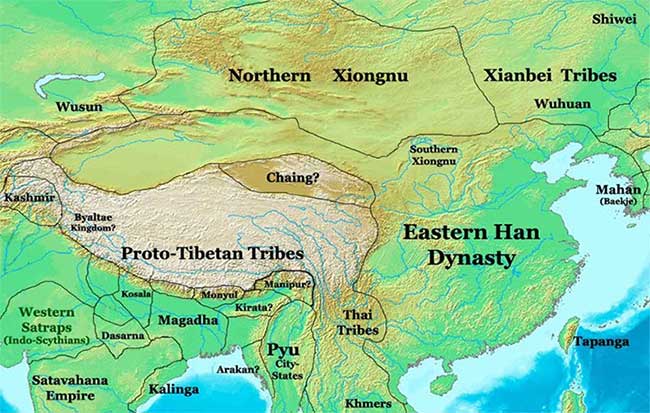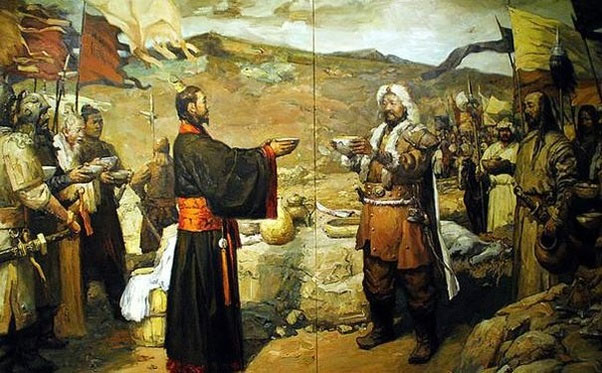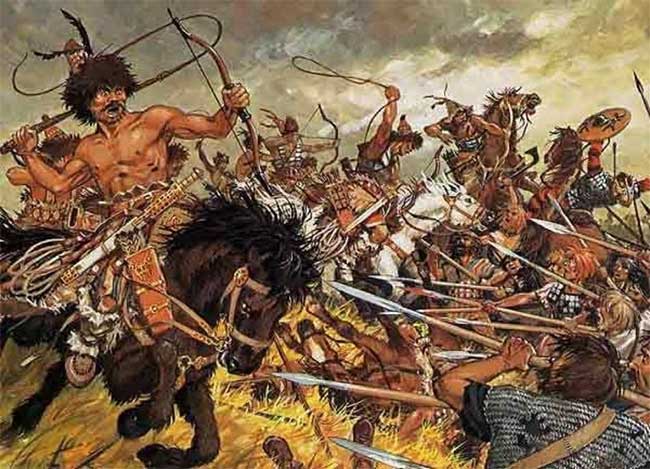The Great Journey of the Huns: Leveling Central Asia, invading and capturing Rome in tribute
After being weakened and divided by the Han Dynasty, a part of the Huns decided to migrate to the west, opening a whole new history for this warlike nation.
In the years between 48 and 60 AD, the Huns essentially weakened and exhausted after successive defeats against the Han, which led to the empire being split into two territories. individual.

Map of Northern and Southern Territories after being divided by the Han Dynasty.
At this time, the mighty Hungarian empire was once completely overwhelmed by the Han dynasty. In order to continue to exist, the Huns chose for themselves three paths: some stayed where they were and merged with other ethnic minorities in the north, others went south to convince people. Han, Nan Hung and the rest started a long journey to the west.
The southern part of the Hunos territory was considered by the Han Dynasty as an autonomous region. The meditation schools here became vassals of the Han Emperor and were subjected to frequent dedication, although some of them still started to fight against the oppression of the Han people, typically the revolt of Vu An meditation. Quoc in 94.
In 216, Cao Cao re-divided the entire territory of Nam Hung Nao into 5 sets: left, right, north, central and south. Each ministry was allowed to appoint a member of the Huno nobility as its leader, but it must be under the supervision of a Han Chinese official. This was to prevent rebellious germs from the exiled Huns, as well as to allow Cao Cao to freely use the Huns as auxiliary forces for his cavalry.

The South Vietnamese government fully convinced and became the autonomous territory of China.
These fluctuations indirectly accelerated the Hanization process of the Huns in the South. Most of the Hunos' aristocracy changed their name here in the Liu family, at the same time wearing costumes and learning the Han's way of life to preserve their prestige and prestige. Many Huns nobles also claim to be related to the Han royalty.
The Huns also settled in the northern steppe, collectively known as the North Hungarians . Although still outside the control of the Chinese dynasties, before the continuous attacks of the Han and the South Huns during the period from 89 to 91, the North Hungarians resisted, forced to carry out Large-scale exodus to the west.
The great migration of the Huns began from the Mongolian plateau, passing through Xinjiang, then to Central Asia, across the vast prairie region of southern Russia, and finally stopping at the Danube basin. in Eastern Europe, with a distance of more than 10,000 km, and a time span of up to nearly 300 years.
The entire westward movement of the Huns was slow and gradual, divided into three main stages: the first, from 91 to 160, mainly to areas of today's Xinjiang. ; the second phase, from 160 to 373, to areas from the Aral Sea to the Russian Volga and East Rivers, and the third, from 374 to 468, to Eastern Europe with The major settlement area is in Hungarian territory today.
First stage (91-160)

The North Hungarians have made a great journey to the West, with a distance of 10,000km over 300 years.
The first exodus of the North Vietnamese to the West was marked by the invasion of the Kingdom of O Ton - one of 36 ancient countries in the Western Region (now in the Xinjiang territories, east of countries). Kazahstan and Kyrgyzstan), and settled there for 70 years. During this time, the North of North East sent envoys to the Eastern Han Dynasty twice to propose reincarnation in the years 105 and 106, but were rejected.
The presence of the Huns in this area was determined by archaeologists through the discovery of their tombs in areas north of Xinjiang, from Lake Barkol to the Turfan boundary, and from the Hoa Tinh region. , Xinjiang to the eastern regions of Kazakhstan territory.
Around 160 AD, the Northern Territories were attacked by the Tien Ti and recaptured previous territories of the Kingdom of O Ton. The Huns must continue to migrate to more remote territories in Central Asia.
Phase 2 (160-373)
During this period, the Huns had long since disappeared from Chinese history, but for the first time appeared European historical documents called 'Huns' , with records of invasions. in Central Asia and Eastern Europe in the 4th century AD.
Over a period of 100 years, the Huns have repeatedly waged war with the dynasties of Persia, Mesopotamia, even with the kingdoms of North India for a long time, so it was ordered by Indian history for names like "Huna" or "Sita Huna ".

The Huns have repeatedly fought with Persia and the kingdoms of northern India in Central Asia.
Roman historian Amianas records the downfall of the Alan kingdom (an ancient nomadic group in Central Asia, closely related to the Persians) from the onslaught of the Huns: 'In the year 350 AD, the armies of the Huns and Alan fought fiercely along the coast. The Huns won, the king Alan was killed, the kingdom of Alan was destroyed, and the surviving Alans had to surrender to the Huns or flee to Rome. After the destruction of Alan's kingdom, the Huns continued to move west to the Volga and East rivers for a few years, to continue their direct attack on Europe. '
Phase 3 (374-468)
Since 374, the Hungarians have continued to go further west and invaded East Goth, one of the two kingdoms of ancient Germanic tribes in the Danube basin, next to West Goth, in present-day Romania and Hungary. . It was precisely the time when Europe shook before the hooves of the nomads from the east.

The first impression of the Huns in Europe was the successful invasion of the territory of East Goth.
After the destruction of East Goth, the West Goths were no different from birds scared of curved branches, pulling together to flee. In 376, they sent a representative to worship the Western Roman Empire, and was approved by the Emperor of Western Rome. From there, the West Goths flooded into Roman territory and ceded to the Hunan basin of the Danube basin.
The Huns, after conquering the Danube basin, continued massively to the south, invading the Eastern Roman Empire to the heart of Constantinople. In dire circumstances, the king of Eastern Rome had to accept the submission to the Huns and annually sent out 2,100 taels of gold, and at the same time ceded them to most of the Balkan Peninsula.
In 444, the Hungarian empire in Europe was formally established in the Danube basin, with its leader, Attila, who was nicknamed 'the whip of God' by Western historians. The Hungarian border lies across Europe and Asia, east from the Persian Sea to the west of the Rhine, south to the Balkan Peninsula, north to the Baltic Sea. The emperors of East and West Rome and the heads of many small nations in Europe had to submit and submit their annual tributes to the Hungarian empire.
The horses' hooves continued raging across Europe for another 20 years, until Attila died.
- Strong earthquakes in Central Asia, 14 people were killed
- The truth falls back on the culprit who burned into Rome
- Leveling Nha Trang Bay
- Horror 'storm' mouse tribute to the capital of Paris
- Strong earthquakes shake Central Asia
- Mysterious labyrinth under Rome
- Ground leveling is controlled by laser
- Iceland successfully tested the method of 'capturing and confining' CO2 permanently into the ground
- Cross the Antarctic according to Shackleton's journey
- Neanderthals used to eat dead people
- Tien Giang applied flattening fields with lasers
- Recreate Rome in 1 day
 'Fine laughs' - Scary and painful torture in ancient times
'Fine laughs' - Scary and painful torture in ancient times The sequence of numbers 142857 of the Egyptian pyramids is known as the strangest number in the world - Why?
The sequence of numbers 142857 of the Egyptian pyramids is known as the strangest number in the world - Why? History of the iron
History of the iron What is alum?
What is alum?